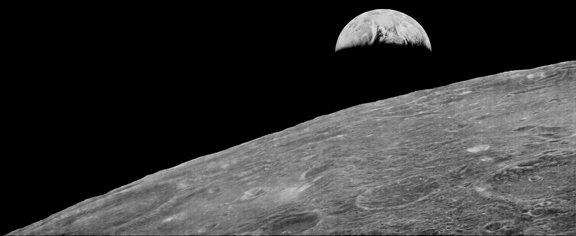Old Moon Images Get Modern Makeover

This story was updated at 1:17 p.m. EDT.
WOODLANDS, Texas — Images of the moon gleaned from NASAspacecraft more than 40 years ago are now getting a 21st century makeoverthanks to the Lunar Orbiter Image Recovery Project (LOIRP).
Back in 1966 and 1967, NASA hurled a series of Lunar Orbiterspacecraft to the moon. Each of the five orbiters were dispatched to map thelandscape in high-resolution and assist in charting where best to set downApollo moonwalkers and open up the lunar surface to expanded human operations.
By gathering the vintage hardware toplayback the imagery, and then upgrading it to digital standards, researchershave yielded a strikingly fresh look at the old moon. Furthermore, LOIRP?sefforts may also lead to retrieving and beefing up video from the firsthuman landing on the moon by Apollo 11 astronauts in July 1969.
Digital domain
Dennis Wingo, LOIRP?s team leader, detailed the group?s workin progress during last week?s 40th Lunar and Planetary Science Conference.
Teamed with SpaceRef.com, LOIRP?s saga is one ofacquiring the last surviving Ampex FR-900 machinery that can play analog imagedata from the Lunar Orbiter spacecraft. Wingo noted that the work is backed byNASA?s Exploration Systems Mission Directorate, the space agency?s InnovativePartnership Program, along with private organizations, making it possible tooverhaul old equipment, digitally upgrade and clean-up the imagery viasoftware.
Get the Space.com Newsletter
Breaking space news, the latest updates on rocket launches, skywatching events and more!
LOIRP islocated at NASA?s Ames Research Center at Moffett Field, Calif. There, projectmembers are taking the analog data, converting it into digital form andreconstructing the images.
By moving them into the digital domain, Wingo said, thephotos now offer a higher dynamic range and resolution than the originalpictures, he added.
?We?re going to be releasing these to the whole world,?Wingo said.
Use of the refreshed images, contrasted to what NASA?supcoming Lunar Reconnaissance Orbiter (LRO) mission is slated to produce, hasan immediate scientific benefit. That is, what is the frequency of impacts onthe Moon?s already substantially crater-pocked surface?
?We?ll be able to get crater counts,? Wingo told SPACE.com.?LRO imagery of the same terrain imaged decades ago will provide a crater countover the last 40 years.?
Frozen intime
There?salso a more down to Earth output thanks to LOIRP scientists.
They have useda Lunar Orbiter 1 image of the Earth for climate studies, basically a snapshotfrozen in time that shows the edge of the Antarctic ice pack on August 23,1966.
The team isworking with the National Snow and Ice Data Center in Boulder, Colorado tocorrelate their images of the Earth with old NASA Nimbus 1 and Nimbus 2spacecraft imagery that flew at about the same time — in the mid-1960s — as theLunar Orbiter 1. Nimbus satellites were meteorological research and developmentspacecraft.
Wingo said thatthe original Nimbus images may have been recorded on an Ampex FR-900 — so byprocessing the original Nimbus tapes there is a very good chance that they canprovide NASAwith polar ice pack data from ten years earlier.
Lessonslearned
One treasure hunt outing by LOIRP may lead to finding whatsome term as ?lost? Apollo11 slow scan tapes, Wingo said.
?We don?t think they are lost. People have been looking forthe wrong tapes,? he said, explaining that they were recorded on Ampex FR-900equipment ? not on another type of recorder as previously thought.
Wingo said those Apollo tapes are stored at the FederalRecords Center, labeled and ready for a look see.
?We think for the 40th anniversary of Apollo we may be ableto get the original slow scan tapes,? Wingo said. If so, the hope is to recoverthem and give the public a higher-quality, never-before-seen view of humanexploration of the Moon.
There is a lesson learned output from LOIRP.
In the beginning, very few people thought this could bedone?but now they have seen the results,? Wingo said.
It is not enough to have 100 year recording medium, Wingoexplains. Without the retention of the specific era equipment that images arearchived on, it will be impossible for future generations to recover older NASAor other satellite data, he advised.
This is a general issue, not specific to the Lunar Orbiterprogram. The retention of critical hardware should be a requirement for flightefforts. The original historic Apollo 11 slow scan images have been lost due toinattention to this critical detail, Wingo concluded.
- Video - Apollo 11: The First Moon Men
- Video - Direct From the Moon
- Skywatcher's Guide to the Moon
LeonardDavid has been reporting on the space industry for more than four decades. Heis past editor-in-chief of the National Space Society's Ad Astra and SpaceWorld magazines and has written for SPACE.com since 1999.
Join our Space Forums to keep talking space on the latest missions, night sky and more! And if you have a news tip, correction or comment, let us know at: community@space.com.

Leonard David is an award-winning space journalist who has been reporting on space activities for more than 50 years. Currently writing as Space.com's Space Insider Columnist among his other projects, Leonard has authored numerous books on space exploration, Mars missions and more, with his latest being "Moon Rush: The New Space Race" published in 2019 by National Geographic. He also wrote "Mars: Our Future on the Red Planet" released in 2016 by National Geographic. Leonard has served as a correspondent for SpaceNews, Scientific American and Aerospace America for the AIAA. He has received many awards, including the first Ordway Award for Sustained Excellence in Spaceflight History in 2015 at the AAS Wernher von Braun Memorial Symposium. You can find out Leonard's latest project at his website and on Twitter.









